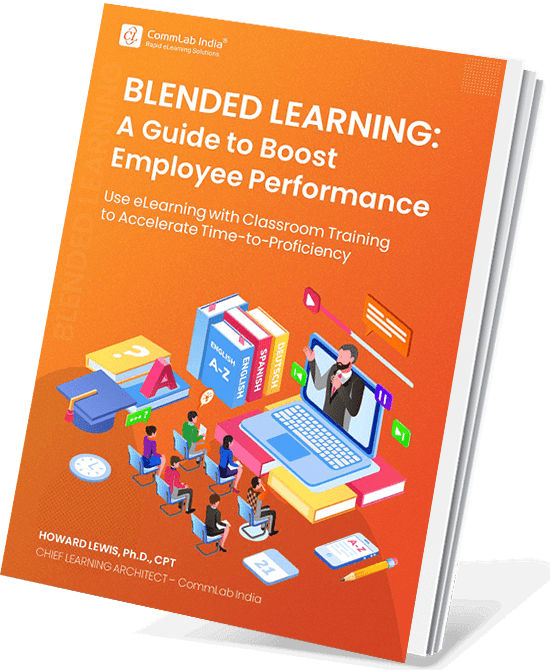Blended Learning for Corporate Training – The When and the How

For years, companies across the world trained their employees in an instructor-led environment. The classroom training methodology is very effective in helping learners acquire knowledge and skills. The presence of a trainer makes the learning process engaging and ensures learners take an active part in the learning process. However, the traditional method of training is highly inflexible. Learners have to follow fixed training schedules and cannot chart their own learning paths. To overcome this limitation of brick and mortar classrooms, several organizations are going for mixed-mode learning solutions, where employees attend trainer-led sessions and complete self-paced online learning modules, outside the classroom. In a mixed-mode learning program, some part of the time usually spent in an instructor-led session will be substituted or supplemented with online learning experiences. Technology-enabled learning and classroom training components will complement each other to provide rich, holistic learning experiences. Today, we will examine the training situations where a hybrid learning approach works best. We will also see how to formulate a successful blended learning strategy.
→ Download Now: Blended Learning — A Guide to Boost Employee Performance [eBook]
When do hybrid learning solutions deliver the best results?
1. Content is complex and needs to be delivered in a short time
Some training programs require more time because they involve a deeper understanding of the subject. Take for example, training technicians on a complex piece of machinery in a nuclear power plant. Operators need to know the steps to use the machine and have a good understanding of how it functions. They also need to be aware of the precautions to be taken while using the machine. It may take several weeks for training the technicians effectively, in an instructor-led setting.
However, if you blend classroom training and e-learning methodologies, you can reduce training time considerably. This is because more content can be delivered in less time using multiple learning methods, each complementing the other. A good learning blend also helps learners absorb content faster and better. The same is true for training programs delivered to medical reps and salespeople of insurance companies who deal with complicated products.
2. Learners are dispersed across the globe
There is a limit to the reach of classroom training programs. That does not mean others in the organization do not need training. They simply are deprived for logistical reasons. This need not be the case when you adopt a hybrid learning strategy. You can include more number of employees – particularly those who work in remote and far-flung places. They will feel included and nurtured with continuous learning opportunities.
3. Training has to be imparted frequently
In certain industries such as the retail sector, employee turnover rates are very high. A large number of staff members join the organization frequently, and organizations must train them. Imagine having to provide classroom training for them, only to see that they leave the organization in a few months. Blended learning is the perfect choice in this situation. You can move most of your training content online, reducing the need for instructor-led interactions in a big way. This will help you get the best ROI on your training dollar because web-based learning materials need to be developed only once and can be used as many times as wanted.
How to come up with a perfect blended learning strategy
You can come up with a good blended learning strategy to teach a job task, based on four important parameters:
- Frequency of execution of the task
- Importance of the task w.r.t. the job of the employee
- Difficulty in learning to perform the task
- Risk involved in performing the task incorrectly

How L&D And Business Can Align to Conquer The Future Of Work
Bridging the Gap Between Organizational and Individual Goals!
- Learning Strategies Shaping the Future
- Changing Role of Learning Professionals
- Learning to Solve Business Challenges
- And More!
Let us try to understand how these four factors can be used to come up with a good hybrid learning approach using examples of two tasks, performed by an accountant.
Example 1: Recording business transactions in the books of account
An accountant needs to record business transactions in the books of account every day. So, the frequency of execution is very high. The task is very important as it plays a critical role in the performance of his job duties. It is relatively difficult to learn how to record transactions, and any errors in recording transactions could lead to serious consequences. So, it is a high risk task.
We see that the task scores high or moderately high on all four parameters. It is better to use a formal learning approach involving classroom sessions by a subject matter expert and highly interactive online courses with scenarios, assessments, and detailed feedback for training the employee (accountant). This is because the employee needs to have thorough knowledge of the subject and clearly understand the consequences of poor performance. You also need to provide on the job support to the employee to help him acquire mastery of the subject.
Example 2: Making a wire transfer to a travel agency for arranging an excursion
Employees do not go on excursions regularly and so, the frequency of making payment for the excursion is low. Similarly, the task scores relatively low on the importance aspect, as it does not have a major impact on the accountant’s job. It also scores low on the learning aspect; all the accountant needs to know is the travel agency’s bank details. The risk of performing the task incorrectly is also low, as it has little effect on the business.
The task scores low or moderately low on all parameters. You can help the accountant perform the task by teaching him how to perform wire transfer using a microlearning module. You can also make the travel agency’s bank details available to him at the point of need i.e., at the time of making the payment.
Thus, you can come up with the right strategy to enable your employees perform job tasks effectively. A good use of learning formats helps enhance training efficiency and provides the best value for your L&D dollar. Come up with an effective learning blend to make your training initiative a big success.





![5 Benefits of Blended Learning That Will Transform Your Corporate Training [Video]](https://blog.commlabindia.com/hubfs/Imported_Blog_Media/blended-learning-benefits-corporate-training-video.jpg)